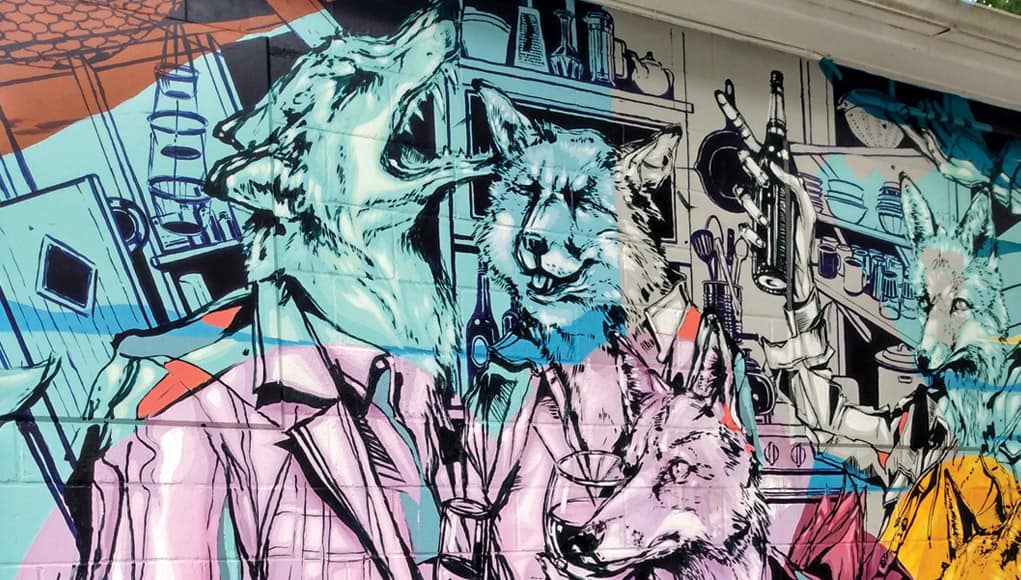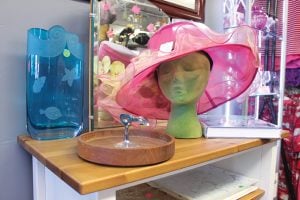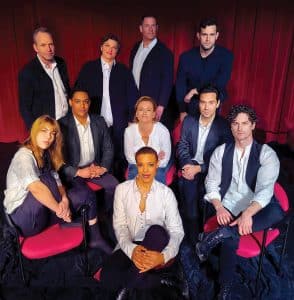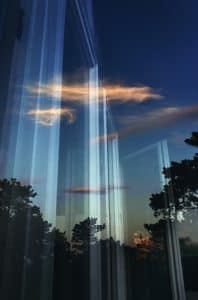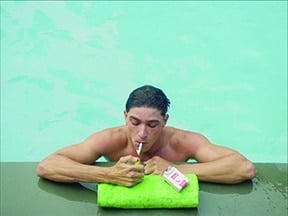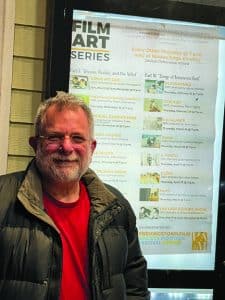Esteban del Valle’s Public Art in Provincetown
by Rebecca M. Alvin
Top Image: Detail of Time and the Town mural by Esteban del Valle
Photo: Rebecca M. Alvin
As you approach Provincetown Harbor by sea, the Pilgrim Monument becomes larger and larger, you pass Race Point lighthouse, and immediately recognize the coastal skyline of the town. But as you pull up to the pier, on the left you also see that profound photographic installation by Norma Holt, five portraits of Portuguese fishermen’s wives staring out at you, inviting you to consider Provincetown’s fishing port heritage. They Also Faced the Sea was installed between 2003 and 2005, and it has been admired ever since. But according to members of the recently formed Provincetown Public Art Foundation Romolo Del Deo and Lise King, in a town with such a rich artistic legacy, public art should be even more of a presence here. And so, the organization, which was only just formed in 2020, began in earnest commissioning artists, beginning with Esteban del Valle, who has just completed the first public project, Time and the Town, a mural on the side of Marine Specialties, at 235 Commercial Street.
King says, “We are attracting people who might never step foot in a museum and democratizing art in Provincetown by bringing it out into the public spaces.”
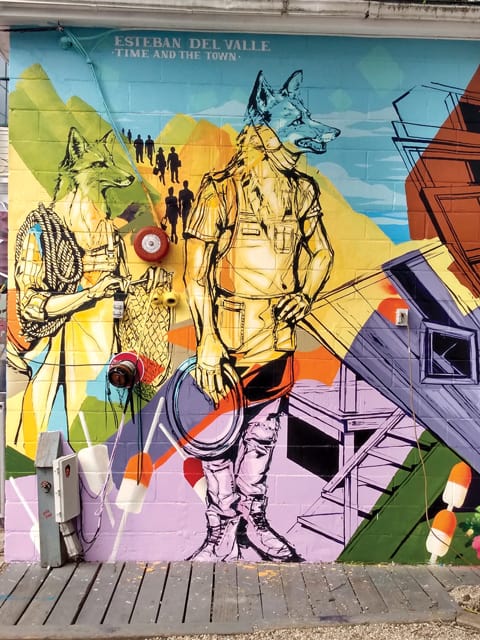
Photo: Rebecca M. Alvin
“We gave Esteban complete creative freedom. The only rule was we didn’t want to upset anyone in the town,” Del Deo explains. “It’s a real love poem to Provincetown… really looking at it with humor and wry commentary but in a very loving way.”
Del Valle says, “This is the best project I’ve ever worked on because of the trust and the faith that they’ve put into me in allowing me that creative freedom. So, I’m very grateful for that and to have that also be an example for future projects and for other artists… It’s like just trust artists, trust them to do something that you didn’t know you needed but now that it’s there, it seems important.”
The Chicago native, who now lives in New York City and is represented here in town by Albert Merola Gallery, began coming to Provincetown while he was a graduate student at Rhode Island School of Design, as part of the process of applying for Fine Arts Work Center fellowships. On his fourth attempt, del Valle was accepted into the prestigious fellowship program and had his first opportunity to live here and experience the unique off-season vibe.
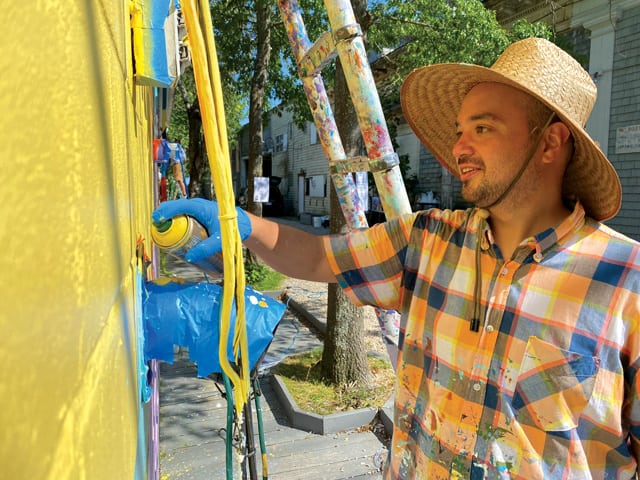
But unlike many public art projects that honor those who came before or remind us of wars, previous pandemics, and problematic histories, del Valle wanted to make a mural that was in the moment—the Provincetown that is right now, while still acknowledging its past.
“I think in a space where art is valued, but so is real estate and fine dining, you know, it’s like sometimes the desire to preserve this place prevents people from building off of the legacy that really founded it, which is a constantly progressing creative spirit,” he explains. “That means that it’s supposed to keep changing and push boundaries. This is where American theater was invented. This is where so many great painters came through. It’s like it should keep evolving. And I think the public art project seems to be a great start to make that conversation have a bigger platform.”
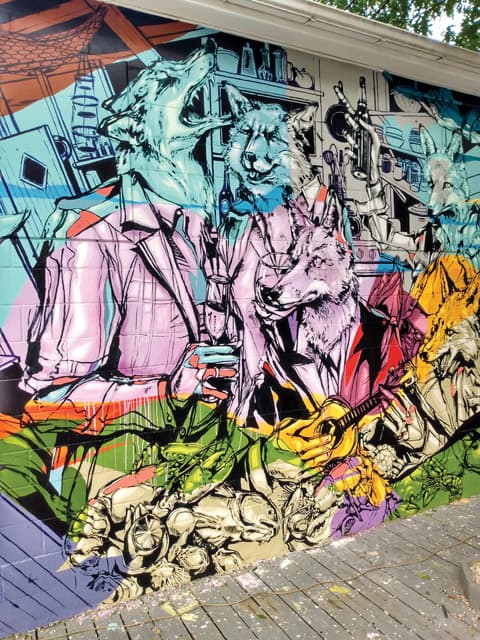
Del Valle says this is one of the most highly visible works he’s done. Some of that attention has been media attention, including del Valle being honored as the featured artist in the 2021 issue of Provincetown Arts, but it’s also been through interactions with the public. It got to the point where del Valle says just about half his work days were taken up with talking to people rather than painting, which was a blessing and a curse, but definitely a unique experience. Strange as it might seem for someone to just interrupt an artist wearing headphones and painting to take a selfie with his work-in-progress (which did happen by the way), del Valle says it points to one of Provincetown’s many unique qualities.
“See in a normal place, most places, it wouldn’t [happen],” he laughs. “But the thing that I realized, it was an interesting observation, was that the actual activity of this town is to walk and look at stuff and then to engage with that stuff. And it’s an art community, so all these people seeing art happening were so excited, and they can go into any other gallery and talk to the person and ask questions, so why couldn’t they do it to me?”
Del Valle has often made political art and to a certain extent there is a political aspect to the mural in the form of subtle social critiques and observations about divides between different groups here. And yet the work does not feature humans. It is dominated by foxes, that ubiquitous carnivore many of us have delighted to see on a regular basis, even right on Commercial Street in quieter months. Del Valle says this mural is directly tied to one he did in Austin, Texas, called The Four Horsemen Killing Time, which he describes as inspired by Albrecht Dürer’s print The Four Horsemen meets Cassius M. Coolidge’s Dogs Playing Poker.
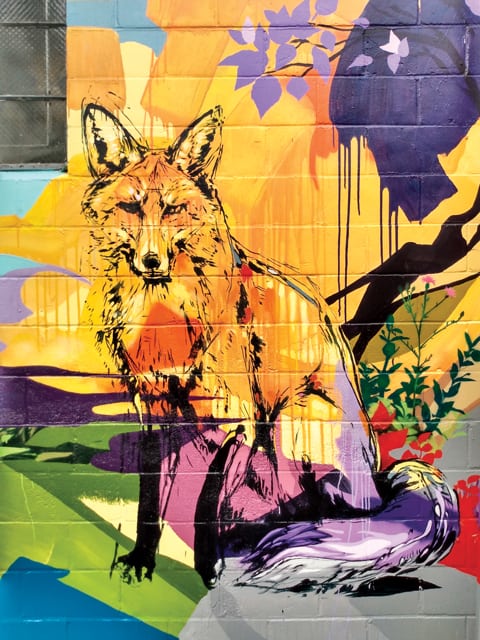
For Time and the Town, which is named for Mary Heaton Vorse’s famous book about Provincetown, del Valle very consciously chose to use personified animals instead of human forms.
“Early on I realized that it was impossible to physically represent the wide range of people that have and continue to pass through Provincetown in its history. Normally some community murals take a selective icon approach, where they’re picking and choosing historical figures or community figures to focus and highlight. And I just wanted to talk more about the spirit of the place and less about specific people, so foxes became a great way to kind of talk about different time periods, different people passing through, and the overall history versus focusing on individuals,” he explains.
Art in public spaces can be tricky because the idea is to create something meaningful and somehow connected to the community or the space in which it resides, but at the same time if something is too alienating to a particular group or viewpoint, the work itself can be overshadowed by public resentment and perhaps even alienate some people from the work rather than drawing them in. In his time living here, visiting here, and working here, del Valle has distilled a set of observations about the tensions, the subtle and not so subtle divisions, and the overall unique aspects of life here year-round. “This wall to me is very layered. Like the main things I wanted to address were the housing shortage and this kind of divide of who gets to be here and why and when. So the wall uses that kind of metaphor of the foxes in the allegory format to present something that’s accompanied by a dynamic aesthetic, colorful, but the point of my work is often to pull you in. And then if you stop and ask questions, like ‘Wait, what’s happening? Why is the server person and the fisherperson/fisherman fox, why are they standing outside the dune shack while these few people are having this party? Why is the server fox the only one that still has a mask on?’” he explains.
In addition he specifically highlights the position of the artist with a plein air easel set up and no artist there. As a special nod to the late Pat deGroot, he put one of her favorite obsessions, a cormorant, on the canvas in the setup. So there is evidence of the artist, but also an absence.
“You have this dune shack party where these people have this seafood feast, and then on the side, the artist fox, the wild fox over there, all that there is is this painting of a cormorant. So it’s that idea that like all they get to eat is their art while this feast is going on, and the idea is, where is the artist, you know? But it’s very complicated, it’s not straightforward. I think one of things I was hoping to get across in this mural is it’s not like a scathing judgment, it’s an observation and one that includes me in it,” says del Valle.
The Foundation has two other projects already in the pipeline, one of which, a sculpture by Penelope Jencks, will be the subject of an upcoming fundraiser at the Mary Heaton Vorse house (see page 12). For Provincetown, it appears to be an extension of a movement to bring the art out into the streets. We’re used to seeing artists working right out in front of galleries, on the wharf, on the beach, and now the plan is to put the resulting art out on the streets, as well. For del Valle, the project has been an important one to add to his already prolific and impressive body of work, which includes not just murals but many other forms and spans a wide range of locations.
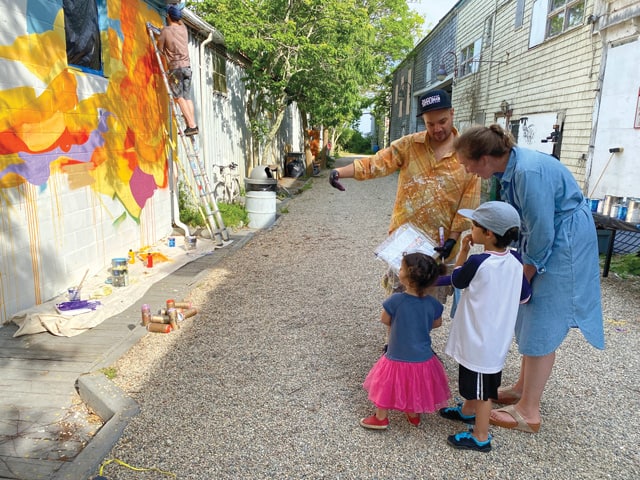
“For me, my own personal relationship to this place and what I’ve experienced first hand, it’s never been black and white. It’s very all over the place. I’ve had wonderful visitors who have opened up their homes, who know nothing about this place, despite coming here for 20 years. I ve met terrible locals, you know,” he says. “More than anything, I just realize that this place means something to everybody that passes through it, and I wanted to honor that for myself and for other people. A mural’s not just a stage for some oversimplified political conversation. Everybody has a personal attachment, and I love it here. And I want to live here year-round. And I would if I could. So, still trying to figure out a way.”
Esteban del Valle’s mural Time and the Town is visible on the side wall of Marine Specialties, 235 Commercial St. The plan is to include a QR code onsite for expanded information about the mural some time in the near future. To learn more about del Valle or see more work visit Albert Merola Gallery, 424 Commercial St., Provincetown, albertmerolagallery.com or visit the artist’s website at estebandelvalle.com. For information about the Provincetown Public Art Foundation, visit provincetownpublicart.org.

